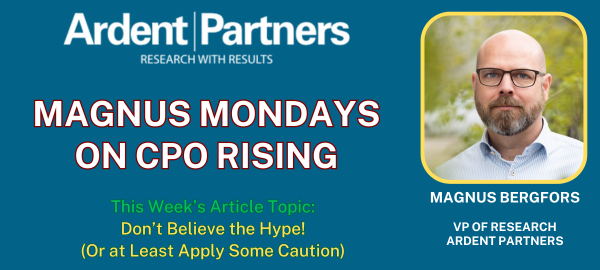Back in 1996, Bill Gates wrote “We always overestimate the change that will occur in the next two years and underestimate the change that will occur in the next ten. Don’t let yourself be lulled into inaction.” I keep coming back to this quote as I watch the hype take off for various technologies and concepts.
The Hype Cycle Effect
Since 1996, the timescales have shortened, but the basic idea still holds true: It takes longer than we think or expect for new technology to reach a significant impact level. This is reflected in one of the most well-known analyst reports, the Gartner Hype Cycle (which I authored in the past). For those that don’t know this report, it argues that all so-called “technology profiles” (Gartner’s name for the “dots” on the actual graphic) go through a series of stages, starting with a steep rise in market interest and hype as expectations increase to what they call a “peak of inflated expectations.” The problem is that the actual technology rarely, if ever, develops at the same speed as the expectations. Once users realize this gap, the technology falls into the “trough of disillusionment.” But as the technology starts catching up with the expectations, the technologies start climbing towards the “plateau of productivity” and become mainstream.
There’s plenty of criticism against Gartner’s Hype Cycle (some listed here), but one of my main issues is that Gartner (and in many cases, other analysts) plays a big role in creating the hype. Although the role of the analyst should be to provide a balanced and informed opinion, they often add to it, especially in various technology evaluation reports where solution providers are frequently rewarded for having as many bells and whistles as possible.
Shiny Object Syndrome
This article is applicable today because buying organizations need to be cautious when it comes to new technologies, which, more often than not, are overhyped. One cautionary (and recent) example is blockchain. There is enormous potential, especially on the transactional side, for blockchain to add value to the modern procurement operation, but there are significant technical (i.e., performance and latency), regulatory, and standardization issues that must be addressed. At one point, during the period of peak hype, blockchain became a “technology looking for a problem,” (i.e., organizations wanted to use blockchain because they heard that others were doing it, but they didn’t know what to do with it or, for that matter, how it worked.
And here lies the problem. By nature, we’re so easily attracted to the bright, shiny, new thing (shiny object syndrome), that we fail to realize the shine can be blinding. We desperately want to use this new toy when we should simply take a step back and see if the solutions prove to address any of the current problems.
Another, and more current, example is generative AI. Generative AI burst onto the scene with the release of ChatGPT in late 2022. Since then, interest and expectations have climbed steadily. There are plenty of interesting use cases for large language models (LLM) technology in procurement and sourcing (LLM can be described as the text/language subdivision of generative AI). But beware of “AI washing” and use cases where other, more tested (and reliable) technologies such as rules-driven workflows and templates, can do the job. At this stage in its early development, generative AI should only be used where the cost of error is low and rigorous governance can be applied. The AI algorithms have no “understanding” of right or wrong, they simply predict the next word based on advanced statistics and semantics.
Without guardrails, a generative AI application can make up answers, with no factual basis or support. Even if there are ways of reducing the risk of this so-called “AI hallucination” by training or fine-tuning the models on use case specific data (not a trivial exercise) or using retrieval augmented generation (RAG), the risk doesn’t completely go away. That said, using LLM’s to summarize contracts, create draft category plans, and the like, can provide a significant productivity boost — if the solutions are trained on the right data, used by professionals that understand their current limitations, and institute the proper governance.
Hype Is Hype — Use Caution
So, don’t believe the hype! Listen to the hype and make sure you understand the actual topic, what the underlying technology can do, and how it applies to your business problems. In other words:
- Don’t fall in love with any technology. Focus on the largest business problems at hand and understand what technologies can best address them. For most procurement organizations, there are tried and tested technologies and tools that should be deployed first before engaging the latest hyped solution(s). But make sure to discern between new solutions using established technology to solve problems and the latest over-hyped fad.
- Build knowledge and competence. Understand the actual maturity of the technology before making any significant investments or relying on it for business-critical processes. Begin with experimentation or a small investment to test the waters. Build expertise and understanding before full-scale deployment or focusing on other technologies for the future.
- Don’t be lulled into inaction. Bill Gates’ statements are generally self-serving (after all, can any reader name a truly innovative breakthrough in MS Office since the late 1990s?). The truth is many of the most over-hyped technologies (like AI) are going to have a significant impact in the long term. But make sure you comprehend the technologies in question.
Ardent Partners is happy to provide advice and support when it comes to understanding the application and maturity of procurement technology and solutions. We will also be publishing reports on these topics. In the meantime, don’t hesitate to reach out to us.
RELATED RESEARCH
CPO Rising Listicle: Nine Ways to Gain Company Software Adoption
Looking Back, Around, and Ahead on Procurement Technology Adoption
Artificial Intelligence for Procurement Gets a Reality Check

